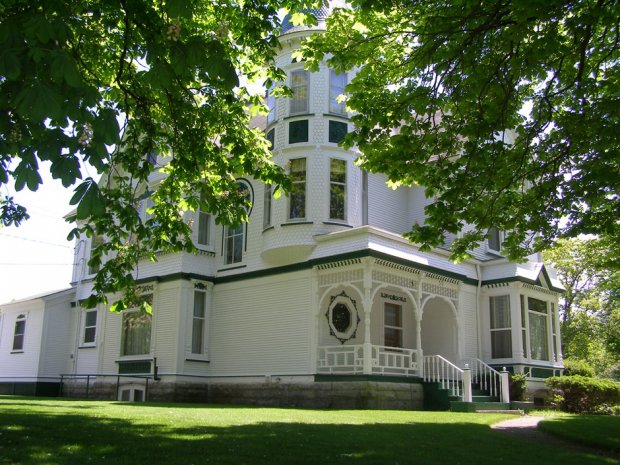By Charles Lewis
National Post
June 14, 2011
http://life.nationalpost.com/2011/06/14/catholic-church-in-nova-scotia-selling-prized-victorian-mansion-to-pay-legal-bills/
 |
| This stately home built in 1892 became Rome Catholic Church property. But because of the need to raise money to pay abuse victims, it’s now on the market for $429,000. It is 7,000 square feet and sits on a property greater than 24,000 square feet. |
The three-storey Victorian mansion on Park Street in Yarmouth, Nova Scotia, is considered one of the town’s prized possessions, a treasure of unique architecture, craftsmanship and exquisite detail.
The top of one of the towers is a “cozy den which might be used as an observatory, so grand a view of sky, land, and sea does it command,” an area columnist wrote recently of just one unique characteristic of the property.
It is called the “bishop’s residence” by locals because it is owned by the Roman Catholic Diocese of Yarmouth even though a bishop has not lived in the Church property for nearly a decade.
But this stunning property, which measures more than 7,000 square feet and was built in 1892, is now the symbol of what it will take to pay the price for nearly four decades of abuse inflicted on locals by faithless priests. The Church is trying to sell the home for $429,000 as part of its efforts to raise nearly $2-million, the total amount expected to settle all the cases.
“We’re all aware that in order to make these settlements we have to part with our treasures and that’s happening anywhere where the Church is being sued,” said Marilyn Sweet, communications officer for the Archdiocese of Halifax and Diocese of Yarmouth. “The Church doesn’t have extra money lying around to put into those things so it cuts to the bone for all of us. The building is important to the people, but there is a greater sense of making it right, to do what we can, and come to a place where these matters are settled and the Church moves on.”
The house, along with two commercial properties also owned by the Church, are expected to bring in more than $600,000. The rest of the $2-million will be raised by the diocese’s 20 or so parishes which will collectively raise money from a variety of sources, including interest on investments and bake sales.
The settlement stems from 22 cases involving eight priests that began in the 1940s and believed to have ended in the late 1970s. To date, 14 cases have been settled through mediation. Ms. Sweet said that given Yarmouth is a small diocese so there is no single place to draw enormous sums of money.
In the spring, Archbishop Anthony Mancini of Halifax held a series of public meetings to talk about the sexual abuse cases and also to answer questions about meeting the financial burden to pay victims.
People wanted to know why Rome was not providing the settlement funds and why those in parishes where no abuse took place had to still had to pay, she said.
Many in the parishes were surprised to learn that every diocese in the world has to meet its own financial burden and the parishes are responsible for help the diocese meet that goal, Ms. Sweet added. “Rome doesn’t pay our bills,” she said. “Most people had never heard that.”
Yarmouth real estate agent Mike Randall, who is handling the sale of the Church properties, said the house is “one of the grandest properties in Yarmouth” and is considered a landmark of the town.
“It is very unique for the area for the craftsmanship, grand staircase, inlays on the risers, the railings, doors, stained glass, and the woodworking in general,” he said.
Carla Allen, writing in The Yarmouth County Vanguard in April, was even more colourful in her description of the property, describing the “palladian-shaped stair window trimmed with an elaborate owl design of wood.”
“The round corner tower is offset with a finial emerging from the tower’s peak,” Ms. Allen continued. “The upper floor window is trimmed with a gable and queen’s post truss at the front. Scalloped woodwork separates the first and second floors and the eaves are trimmed with fanciful dressing.”
Ms. Allen noted that over the years the home was owned at times by a grocer, sea captains and finally the Church in 1954.
Mr. Randall thinks the home could become an inn or a home for seniors. As a Catholic he said he is aware of the sacrifice being made to right the wrongs of the past.
“It comes down parishioners putting these prized possessions on the market to make good our responsibilities. I call it a move in the proper direction.”
National Post clewis@nationalpost.com
Any original material on these pages is copyright © BishopAccountability.org 2004. Reproduce freely with attribution.